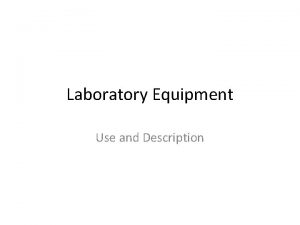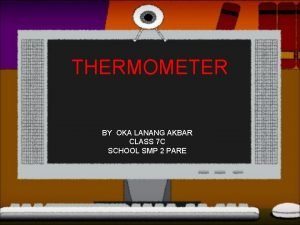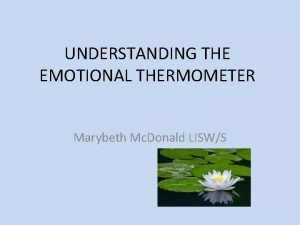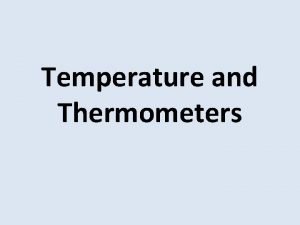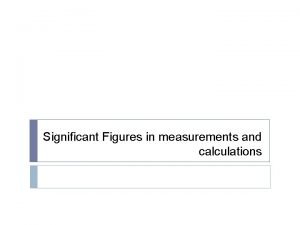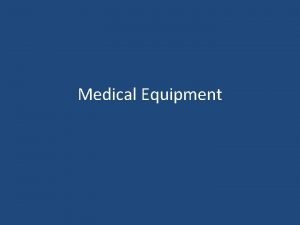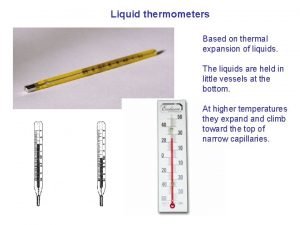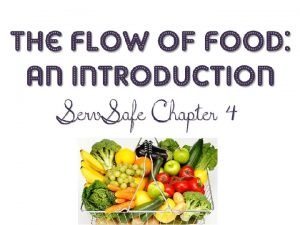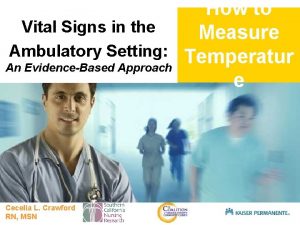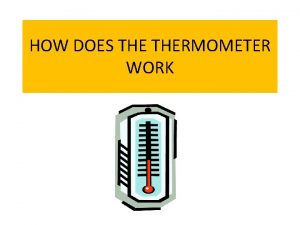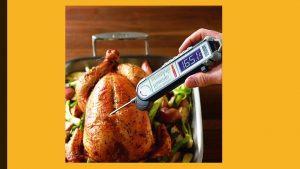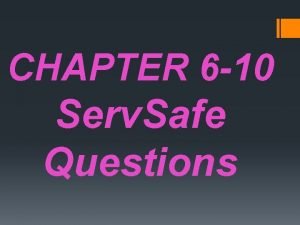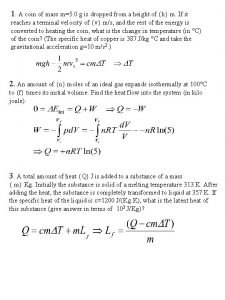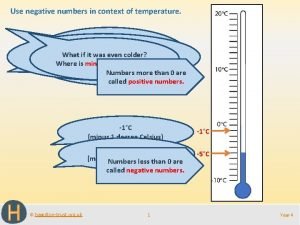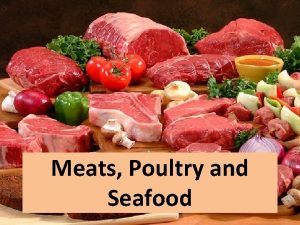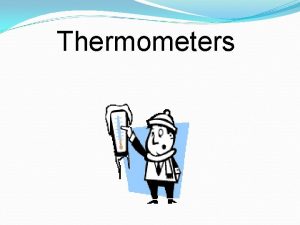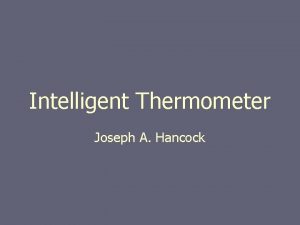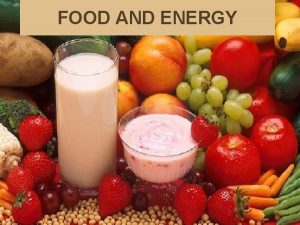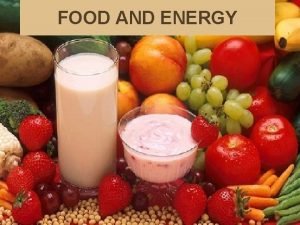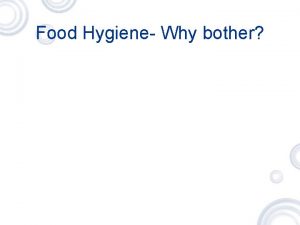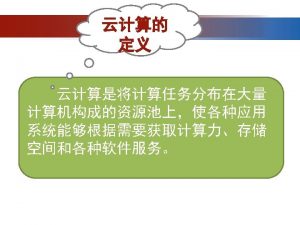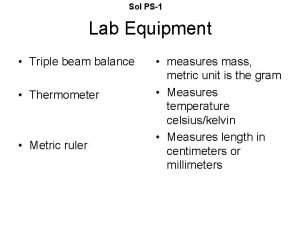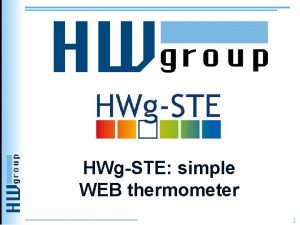FOOD THERMOMETER WHY USE A FOOD THERMOMETER Using





















- Slides: 21


FOOD THERMOMETER

WHY USE A FOOD THERMOMETER? • Using a food thermometer is the only reliable way to ensure safety and to determine desired “doneness” of meat, poultry, and egg products. To be safe, these foods must be cooked to a safe minimum internal temperature to destroy any harmful microorganisms that may be in the food

DONENESS • . “Doneness” refers to when a food is cooked to a desired state and indicates the sensory aspects of foods such as texture, appearance, and juiciness. Unlike the temperatures required for safety, these sensory aspects are subjective.

SAFETY VERSUS DONENESS • The temperature at which different pathogenic microorganisms are destroyed varies, as does the “doneness” temperature for different meat and poultry. A consumer looking for a visual sign of “doneness” might continue cooking it until it is overcooked and dry. However, a consumer using a food thermometer to check for “doneness” can feel assured the food has reached a safe temperature and is not overcooked.

• Cook all raw beef, pork, lamb and veal steaks, chops, and roasts to a minimum internal temperature of 145°F as measured with a food thermometer before removing meat from the heat source. For safety and quality, allow meat to rest for at least three minutes before carving or consuming. For reasons of personal preference, consumers may choose to cook meat to higher temperatures.

• Cook all poultry to a safe minumum internal temperature of 165°F as measured with a food thermometer. For reasons of personal preference, consumers may choose to cook meat to higher temperatures.

• A food thermometer should also be used to ensure that cooked food is held at safe temperatures until served. Cold food should be held at 40 °F or below. Hot food should be kept hot, at 140 °F or above.

TYPES OF THERMOMETERS • Food thermometers come in several types and styles, and vary in level of technology and price.

DIGITAL THERMOMETERS

• Thermocouple: Of all food thermometers, thermocouple thermometers reach and display the final temperature the fastest - within 2 to 5 seconds. The temperature is indicated on a digital display.

• Thermistor-style food thermometers use a resistor (a ceramic semiconductor bonded in the tip with temperaturesensitive epoxy) to measure temperature. The thickness of the probe is approximately 1/ 8 of an inch and takes roughly 10 seconds to register the temperature on the digital display. Since the semiconductor is in the tip, thermistors can measure temperature in thin foods, as well as thick foods. Because the center of a food is usually cooler than the outer surface, place the tip in the center of the

• Thermometer Fork Combination: This utensil combines a cooking fork with a food thermometer. A temperature-sensing device is embedded in one of the tines of the fork. There are several different brands and styles of thermometer forks on the market; some using thermocouples and some using thermistors. The food temperature is indicated on a digital display or by indicator lights on the handle within 2 to 10 seconds (depending on the type).

DIAL FOOD THERMOMETERS

• “Oven-safe” Bimetallic-coil Thermometers: This food thermometer is designed to remain in the food while it is cooking in the oven, and is generally used for large items such as a roast or turkey. This food thermometer is convenient because it constantly shows the temperature of the food while it is cooking.




SAFETY AND DONENESS • Most pathogens are destroyed between 140 and 165 °F. Higher temperatures may be necessary to achieve consumer acceptability and palatability, also known as “doneness. ” These temperatures are recommended for consumer cooking. They are not intended for processing, institutional, or foodservice preparation. Food service professionals should consult their state


END OF REPORT Thanks for listening…
 Alcohol thermometer vs mercury thermometer
Alcohol thermometer vs mercury thermometer Hey bye bye
Hey bye bye Bellani-six thermometer.
Bellani-six thermometer. Dont ask why why why
Dont ask why why why Unit 2 food food food
Unit 2 food food food Sequence of food chain
Sequence of food chain Using system using system.collections.generic
Using system using system.collections.generic Defrost using internal heat is accomplished using
Defrost using internal heat is accomplished using Emotional thermometer
Emotional thermometer Sensitivity thermometer
Sensitivity thermometer Thermometer sig figs
Thermometer sig figs Physical quantity measured by thermometer
Physical quantity measured by thermometer Sylables
Sylables What is the unit of thermal capacity
What is the unit of thermal capacity Bimetallic stemmed thermometer definition
Bimetallic stemmed thermometer definition Where under the tongue to place thermometer
Where under the tongue to place thermometer A bimetallic thermometer relies
A bimetallic thermometer relies Ceramic semiconductor thermometer
Ceramic semiconductor thermometer Signage posted at a handwashing station must include
Signage posted at a handwashing station must include A 300g glass thermometer initially at 25
A 300g glass thermometer initially at 25 Thermometer negative numbers
Thermometer negative numbers Read the thermometer challenge answer key
Read the thermometer challenge answer key
